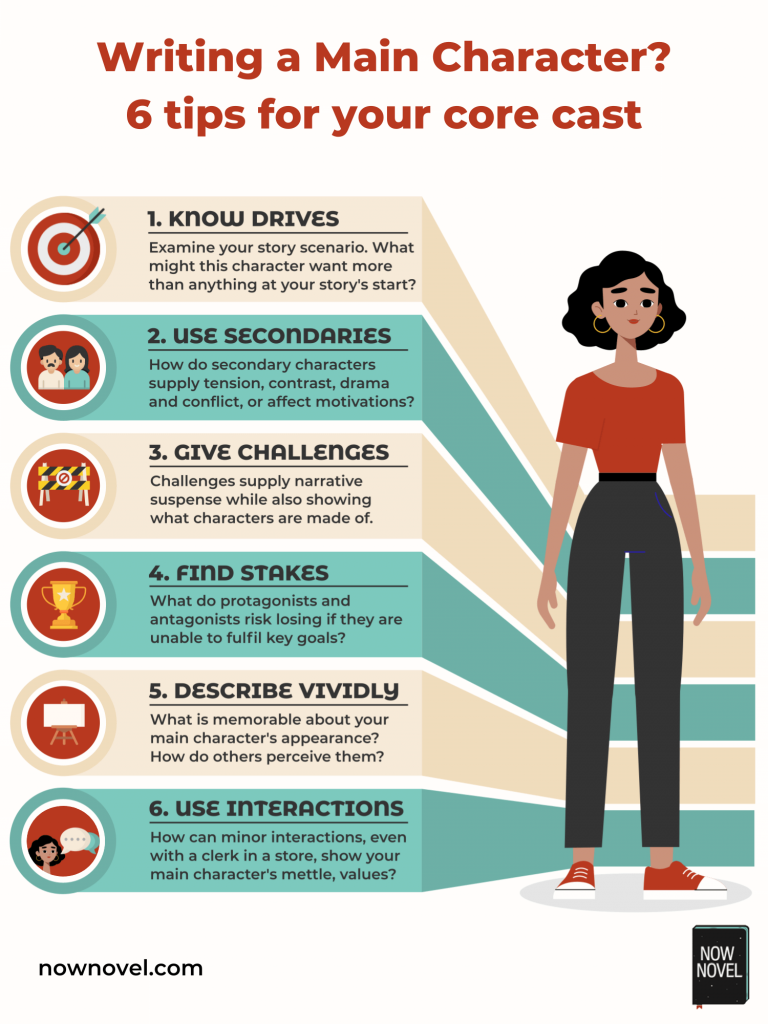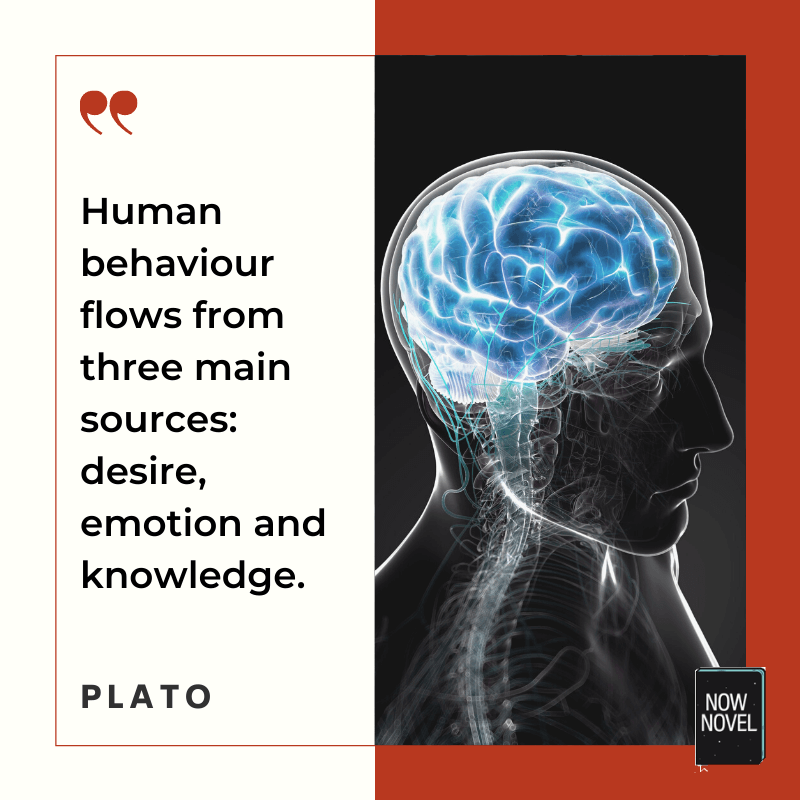The main character in a story is one of the most vital aspects. Knowing how to write an engaging main character is a vital skill for authors. Read on for definitions, examples and tips to make primary characters unforgettable:
What makes a main character?
A main character is a person in a story whose desires, motivations, fears and conflicts are key to the story’s development.
For example, in an adventure/quest novel, a Robinson Crusoe who washes up on an unknown island.
This character is the focus. Secondary characters may be important too. Yet secondary characters are like the ‘best supporting’ category at the Oscars. They may steal scenes, but ultimately it’s not their story.
Even so, good secondary characters (like ‘Trabb’s boy’ in the example from Great Expectations further in this article) can be just as interesting, funny or memorable.
TV Tropes defines a main character thus:
‘Any character who has a major purpose or role in the plot and/or interacts regularly with main characters.’
Main character vs protagonist: What’s the difference?
Although ‘protagonist’ is sometimes used as a synonym for main character, a protagonist is specifically the ‘lead’ character. They’re the ‘main-est’ of all.
You may have multiple main characters, with no single clear protagonist.
Example: A group of four friends who play equal parts in solving a crime, together.
Whoever you choose as the primary character for your story, here are tips to write main characters who matter:
How to write a main character:
- Know what drives your lead character
- Use secondary characters to add drama and contrast
- Give key characters suspense-building challenges
- Brainstorm stakes for each protagonist or antagonist
- Describe central characters vividly
- Develop main characters via minor interactions
1. Know what drives your lead character
What does the main character of your story want? This supplies their motivation.
Once you have the scenario for your story, ask more. For example, for the scenario ‘a girl with a home science makes a surprising scientific discovery’:
- Who might be main characters in this scenario? (for example, the parent or relative who bought the girl the science kit, a teacher who supports her passion of the subject)
- What are the main character’s desires at the start of the story? What immediate obstacles stand in their way?
Brainstorm desires and setbacks using the ‘Characters’ section of the Now Novel dashboard.
Create your first character profile for free now, to create a concise summary you can print out and refer to as you draft further.
Example of a main character’s desire and obstacles
Anne Michaels’ novel Fugitive Pieces opens with a main character, Jakob Beer (a 7-year-old Polish boy) fleeing a Nazi invasion.
The opening pages of Michaels’ novel provide a clear sense of Jakob’s urgent resolve – what he’s compelled to do. For example:
I ran and fell, ran and fell. Then the river: so cold it felt sharp.
Anne Michaels, Fugitive Pieces (1997), p. 7.
Yet there are immediate obstacles (or, in this case, perils) in Jakob’s path. Surviving the outdoors, for example.
These supply initial motivations. They explain actions, such as digging a hole to sleep in:
I knew what to do. I took a stick and dug. I planted myself like a turnip and hid my face with leaves.
My head between the branches, bristling points like my father’s beard. I was safely buried, my wet clothes cold as armour.Michaels, p. 8.
Jakob Beer’s initial desire – getting to safety and surviving – leads to connected actions that convey a strong sense of situation.
Michaels suggests what could happen next, with enough left unknown to keep the reader riveted.

2. Use secondary characters to add drama and contrast
Secondary characters ofent contribute to main characters’ stakes.
For example, a loved one may be in danger. This supplies stakes. The hero desperately wishes to save them, and risks losing them.
Main characters’ complications and motivations involving secondary characters may involve:
- Fearful situations: E.g. A secondary character goes missing (in a mystery or crime story)
- Backstory: Secondary characters’ actions may shape your main character’s fate. For example, a wealthy recluse, Miss Havisham, meddles in profound ways in Pip’s life in Great Expectations, even though she only briefly appears in a chapter
- Societal pressures: The social or other system a character lives within may place pressure on their goals, desires and actions. For example immigrant parents may pressure their foreign-born children to observe tradition
Secondary characters thus provide help or hindrance, comfort or guilt, permission or refusal.
Think about the ways a secondary character may affect your main character.

3. Give main characters suspense-building challenges
Suspense is a key element of any story, although some require more than others.
A thriller novel, for example, wouldn’t seem like much of a thriller without uncertain dangers and tensions.
Even in a romance, however, there is narrative tension. ‘Will they end up together? Won’t they?’.
A main character needs challenges standing between them and their goals. This narrative tension keeps readers interested.
Challenges create exciting rising and falling action
Take two lovers separated by long distance, for example. How will they keep the spark alive?
This question can be shown via scenes that make the outcome of the situation unpredictable.
Challenges assist characterization
An obstacle is a useful plot point to show what your main character is made of.
When there is a bump in the road, do they freak out or take new developments in stride?
Reading back over the opening pages describing Jakob Beer’s flight in Fugitive Pieces, his action is instinctive, urgent. It shows incredible will to survive given the trauma he has undergone.
Your story’s central idea should supply plenty of ideas for challenges for your main characters.
For example, take Cormac McCarthy’s post-apocalyptic novel The Road (2006). In this novel, a father and son journey together after a catastrophe.
The idea naturally suggests possible challenges. Skirmishes with other survivors or cannibals, or simply the anxious situation of having to survive a brutal landscape.
4. Brainstorm stakes for each protagonist or antagonist
‘Stakes’ are a useful concept for developing a main character such as a protagonist or antagonist.
The simple question ‘what does this character have to lose?’ helps you keep the ‘worst case scenario’ in mind.
[You can also brainstorm your main character’s best and worst case scenarios in the ‘Core Plot’ section of Now Novel’s story dashboard.]
The higher the stakes, the stronger a character’s motivation to act.
To take The Road as an example again, the stakes are high – the father must survive to protect his more vulnerable young son, for example.
The tension between this stake and the father’s own vulnerability is what led many critics to call McCarthy’s novel ‘heartbreaking’ and ‘shattering’.
Stakes – and the dance your character does to avoid losing to them – supply a lot of emotional investment for readers.
When thinking about what could happen to main characters, ask:
- What do they have to lose? For example: The love of the object of their affection, citizenship to a country where they desperately want to stay, a job they value or need, a friendship they’re messing up
- How are they vulnerable if the worst comes to pass? For example, a spy who is caught by the enemy is at their mercy
Knowing what each main character has to lose – whether they’re a ‘goody’ or ‘baddie’ – will help you keep their actions driven by believable psychology.

5. Describe central characters vividly
Stories truly spring to life when each character feels vivid.
Often, in beginners’ writing, we read eye colour, hair colour, and lots of grinning.
Your main characters can reveal a lot more through their appearance.
For example, details of dress can tell your reader about the time period (tightly-laced bodices suggesting the stiff discomfort of Victorian England, for example).
Here, for example, Dickens describes how a secondary character, ‘Trabb’s boy’, mocks his main character Pip. Pip has gained overnight wealth thanks to a mystery benefactor.
The boy’s words and actions clearly show his view that Pip now thinks he’s better than others:
‘I had not got as much further down the street as the post-office, when I again beheld Trabb’s boy shooting round by a back way. This time, he was entirely changed. He wore the blue bag in the manner of my great-coat, and was strutting along the pavement towards me on the opposite side of the street, attended by a company of delighted young friends to whom he from time to time exclaimed, with a wave of his hand, “Don’t know yah!’
Charles Dickens, Great Expectations, full text on Project Gutenberg.
From the way the character walks to how he pretends the blue bag is a fancy coat, these small details show his opinion of Pip. They also add humour to the scene.
Via a secondary character we see the main character from another, interesting angle.
Read more about creating characters in our complete guide to character writing.
6. Develop main characters via minor character interactions
This tip follows on from the previous example from Dickens.
What is so good about Dickens’ scene is it highlights Pip’s change of fortune as well as the cons that come with it (estrangement from his humbler roots).
In a single interaction, in Pip’s irritation with the boy’s imitation, we see the gap between Pip’s self-image and how others see him.
These gaps and differences often enrich main characters.
A character might not see themselves as particularly beautiful, for example. Yet when we see every shopkeeper or stranger on the bus tries to flirt with them, we begin to realize they’re more attractive than even they might realise. We realize the main character perhaps has low self-esteem or another good reason for defensiveness.
When you’re drafting scenes involving minor characters, ask:
- What does how they speak to my main character(s) reveal about how they come across to others? Are they more often kind by default? Hostile? Why?
- How does your main character treat others? What does their behaviour or manners say about them? Are they arrogant, dismissive, friendly?
- Think about the various roles secondary characters can serve in developing main characters. How can this character bring your main character closer to or further from their immediate goals?
Get How to Write Real Characters, a workbook with exercises, examples and checklists for writing vivid, believable characters.


6 replies on “Main character writing: 6 ideas for a strong key cast”
I haven’t found a well developed character-driven book I didn’t like, even if it fails to deliver on it’s promise. If the main character entertains, intrigues are pulls at my emotions, it’s worth the read for me.
You’re right, so long as an engaging character (or several) is at the heart of a story, authors can make the most unlikely subjects and plot lines interesting. Thanks for sharing your thoughts, 2Cents.
Raymond Chandler considered plot a secondary issue–characters were everything. Sadly every movie adaptation of his work seemed pathologically driven to knot up the plot to the point that you need a program, map, and GPS to work it. Sadly, at the expense of characters, so by the end you really don’t care all that much.
Late to the party, as usual but I cannot love this more. Can’t wait to share for #WriterWednesday.
This blog is fantastic, and it makes me visualize, hear and feel how a character performs.
Hi Arturo, I’m glad to hear that. Thank you for reading our blog and happy writing!